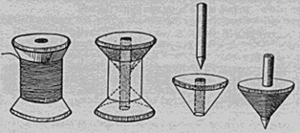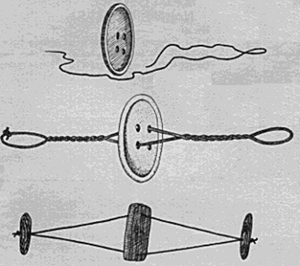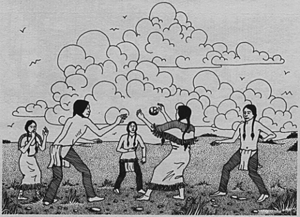From our ancestors to the present day children have been taught
life skills, survival and social and physical development through
games they learn.
Some games involve the thinking processes while others may concern
eye and hand coordination. Although some of the dice games can be
considered gambling it is more involving math.
Over the next few issues I will talk of many different
games and include instructions on how to play them. Below is the list
I will be going in this issue.
|
 1.
Stick Guessing Game 1.
Stick Guessing Game
Materials needed:
| Old Version - |
39 peeled twigs, 18 inches in length |
| Present Version - |
20 - ½ inch dowels cut into 18 inch pieces = 2 per dowel |
Number of people playing = 2
| A. |
One player takes the sticks then behind his
or her back divides the sticks in two bundles. Then the player
brings the sticks in front of his or herself. |
|
|
| B. |
The other player guesses which bundle has
an even number of sticks. |
Scoring
- If the second player guesses incorrectly then the players
interchange positions.
- If the second player guesses correctly then she or he gets
a point. Then the first player restarts the game but putting
the sticks behind his or her back again and divides the sticks.
- After three successful guesses she or he is allowed to
obtain the game point.
- If you want to play this game in groups what you would
do is each team would sit in two lines across from each other.
Then each player would pick a member of the opposite team to
play against.
Scoring - 2 Teams
- If the opponent is incorrect then the other team gets the
point, however the losing team gets to make a guess at which
bundle holds the even amount of sticks.
- If the opponent is correct then that team gets the point
and then the sticks are passed onto the next player on his or
her team.
|
|
 2.
Tops 2.
Tops
Materials needed
Old version
- 1 piece of branch about 3 inches in diameter
- 1 piece of sinew about 3 feet long
| A. |
The parent would carve the branch to look
like a cone with one end pointed |
|
|
| B. |
The sinew would then be wrapped around the
thicker part of the top. |
|
|
| C. |
The pointed end would then be placed on the
hard surface of the ground |
|
|
| D. |
Then the end of the sinew would be pulled
allowing the top to spin |
New Version
- 1 Wood thread spool
- 3 inch wood dowel (one that would fit in the thread spool
center hole)
- 1 - 3 feet piece of carpet thread
| A. |
Cut the spool in half and carve to bottom half into a
cone. Do not put a point on the cone. |
|
|
| B. |
Take the dowel and carve one end to a point then insert
it into the center hole of the spool |
|
|
| C. |
Wrap the carpet thread around the top of the spool. |
|
|
| D. |
Placed the pointed end on the hard surface of the ground. |
|
|
| E. |
Then the end of the thread and pulled the thread allowing
the top to spin. |
Ways to get points
| 1. |
You could gain points by how many spins the top did
until it stopped.
Example: each two turns was a point
|
|
|
| 2. |
Make a square on the ground, if the top goes out of the
square you lose. Each turn it is played equals one point |
|
|
| 3. |
Using the same square try to knock out the other players
tops |
Sometimes in the winter time many tribes played
this on the ice.
|
|
 3.
The Buzzing Toy Game 3.
The Buzzing Toy Game
This toy/game has been said to be just for fun
but I believe it taught science to the children.
Materials needed
Old Version
- 1 antler button with two holes drilled in the center about
1/4" apart
- 1 Piece of sinew or leather thong about 20 inches long
- 2 small bones of a small bird - femur or tibia
New Version
- 1 large two hole button or one disk 1/4" thick made
from clay that is self hardening with two holes in the center
1/4"apart
- 2 small sticks
- 1 piece of leather thong, thick carpet thread or cord
20 inches long
Instructions:
| A. |
Paint the button with your own designs |
|
|
| B. |
Thread the ends of the thong, thread or cord one end
through each hole in the button then tie the two ends together. |
|
|
| C. |
Take the two small sticks and using a lark knot put each
one on an end |
|
|
| D. |
Wind the thong, thread or cord in opposite directions
until it is totally twisted. |
|
|
| E. |
To make it hum or buzz, pull the cords tight and then
let them loose. The disk should spin, go up and down and hum
or sing to you. |
|
|
 4.
Jackrabbits
Hit or Shuttlecock 4.
Jackrabbits
Hit or Shuttlecock
This reminds me of a koosh ball because you can
play with it like you do a koosh ball. It also has been associated
with badminton only without a paddle. The paddle is your hand.
Materials needed
Old Version
- 1 bundle of fresh cornhusks
- 2 - 4 flexible feathers
- 1 yard Sinew
New Version
- 4 pieces of material cut in 6 inch lengths
- 2 - 4 flexible feathers
- 1 yard of colorful yarn or raffia
Instructions: for the Old Version
| A. |
Take two of the green corn husks and form a cross |
|
|
| B. |
Fold another corn husk into a flat square and place it
in the center of the cross. |
|
|
| C. |
Bring up the ends of the cross around the flatted square
and pinch them together to form one bunch |
|
|
| D. |
Just lightly let the top of the bundle loose and insert
the feathers. |
|
|
| E. |
Take the sinew and wrap it starting form the base to
about ½" from the top securing the shaft of the
feathers at the same time |
|
|
| F. |
Cut any corn husks around the top to even them out. |
Scoring
Two or more players can play this, each having
their own jackrabbit. Using the palm of your hand hit the jackrabbit
into the air.
The first one to hit it 10 times without missing
wins the round.
As the players get better increase the winning
number of hits.
If you make the jackrabbit out of corn husks
I do not advise kicking it up into the air as you may tear it
apart faster then hitting it with your hand.
|
|
 5.
Corncob Darts 5.
Corncob Darts
Until a child was old enough to handle a bow
and arrows or a spear they would be taught this game to play to
help teach them hunting and warfare skills.
When I was little my parents made me a modern
version of this game with non-threatening lawn darts made out
of sticks and a Dixie paper cup nailed to one end of a stick and
a plastic hoop made from an old hula hoop that had a few cracks
in it.
When I got older they bought the lawn game -Lawn
Jarts which had metal points. These became outlawed in my state
so my dad used plastic small ice cream bowls and screwed them
onto the ends of the darts to make them non-threatening. We use
to have family tournaments at family gatherings every summer.
Materials needed:
Old Version
Darts
- 2-4 dried corncobs about 3 inches in length
- 2-4 1/4" inch straight sticks cut into 6 inches
long
- 4-8 with shaft feathers
- 1 yard of sinew
Hoop
- 1 bendable stick to form a hoop- enough to form a 12
inch in diameter hoop
- 1 yard sinew to tie hoop together
New Version
Darts
- 2-4 dried corncobs about 3 inches in length
- 1 1/4" wood dowel cut into 6 inch long pieces
- 4-8 with shaft feathers
- 1 yard of colorful yarn
Hoop
- 1 12" plastic hoop or 12" Wood embroidery hoop
- Enough yard to wind around the hoop to make it colorful
Instructions:
Darts
| A. |
Take each 6 inch stick and cut one end to a point |
|
|
| B. |
Insert the pointed end into the soft center of the cob.
Bring it down into the center of the cob slowly leaving 2
inches past the end of the cob. |
|
|
| C. |
Take two feathers and insert the shaft into the soft
center one on each side of the stick. Wrap a piece of yarn
around the shafts and the stick to the top of the stick. Then
cut the yarn and glue the end to make it neat. |
|
|
| D. |
Make each dart the same way. |
Now for the Hoop
| A. |
Take your other yarn and wrap it around the plastic or
embroidery hoop. Make sure to glue the end of the yarn |
|
|
| B. |
If you are going to make a hoop for a bendable stick
- Bend the stick to form a 12" hoop
- With your sinew or Carpet thread bind the hoop ends
together to keep it form coming apart
|
For a substitute to make the hoop you can use
1/2" rope like the kind they use for boats. Sometimes you
can get the rope in colors or in stripes. You can then attach
the ends using a metal clamp.
|
Well this is the end of part one of the Children’
games....Have fun making them and playing them.
Here are some Books on Native American games.. Rent
them from your local library.
|
North American Indian Games
(Watts Library: Indians of the Americas)
Author(s): Madelyn Klein Anderson
Publisher: Franklin Watts, Incorporated
Released: September, 2000
ISBN: 0531164748
|
Handbook
of American Indian Games
Author(s): Allan MacFarlan, Paulette Macfarlan
Publisher: Dover Pubns
Released: June, 1985
ISBN: 0486248372 |
|
|
American Indian Games: A
True Book (True Book)
Author(s): Jay Miller
Publisher: Children's Press
Released: March, 1997
ISBN: 0516260928 |
More Than Moccasins: A Kid's
Activity Guide to Traditional North American Indian Life
Author(s): Laurie Carlson
Publisher: Chicago Review Pr
Released: May, 1994
ISBN: 1556522134 |
|
|
North American Indians (Make It Work!)
Author(s): Andrew Haslam, Alexandra Parsons
Publisher: Unknown
Released: January, 2001
ISBN: 1587283018 |
Native American Games and
Stories
Author(s): James Bruchac, Joseph Bruchac, Kayeri Akweks
Publisher: Fulcrum Pub
Released: September, 2000
ISBN: 1555919790 |
|


 1.
Stick Guessing Game
1.
Stick Guessing Game 2.
Tops
2.
Tops 3.
The Buzzing Toy Game
3.
The Buzzing Toy Game 4.
Jackrabbits
Hit or Shuttlecock
4.
Jackrabbits
Hit or Shuttlecock 5.
Corncob Darts
5.
Corncob Darts